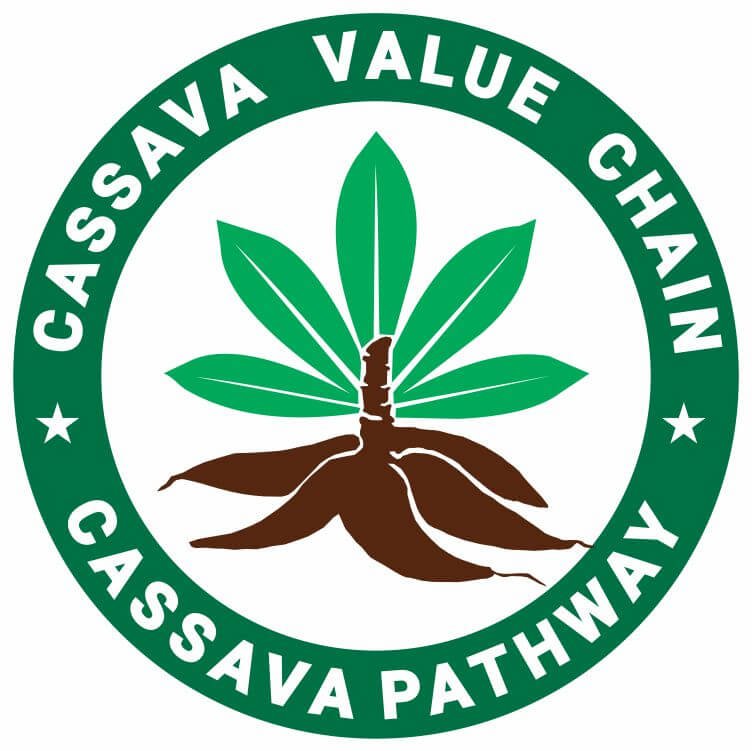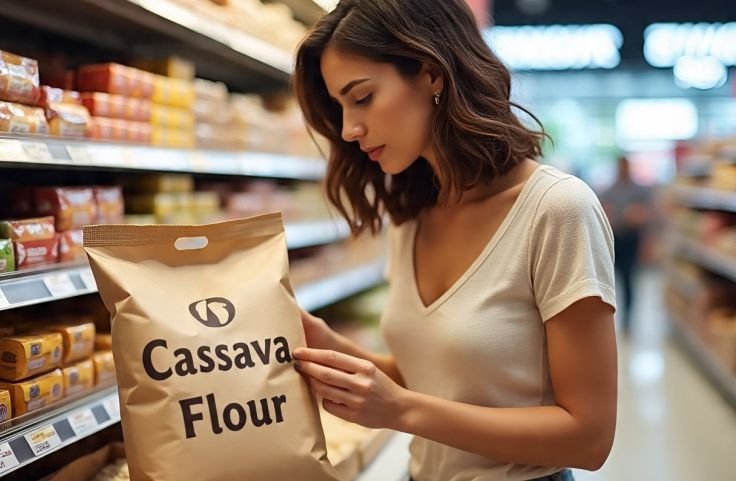Cassava flour buying guide for US consumers: avoid the common traps, know what to look for, and find out where to buy the best brands without wasting money.
Whether you’re trying a new recipe or stocking your pantry with grain-free staples, buying cassava flour in the US can be more confusing than expected.
With a growing number of brands, mislabeled packaging, and varying product quality, it’s easy to make the wrong choice, especially if you’re shopping online or in unfamiliar grocery aisles.
Some bags labeled “cassava” are tapioca starch in disguise, while others come with additives that may not suit your dietary needs.
And then there’s the price. Why do some cost twice as much as others?
This guide breaks it all down, giving you a clear path to finding the right cassava flour, where to get it, what to check on the label, and how to store it once it’s home.
Make your next purchase smarter and stress-free.
Related: Cassava and the American Gluten-free Lifestyle
Table of Contents
- What to Look for When Buying Cassava Flour
- Best Places to Buy Cassava Flour in the U.S.
- Trusted Cassava Flour Brands in the U.S.
- Price Comparison and Buying in Bulk
- How to Store Cassava Flour After Purchase
- Common Mistakes to Avoid When Buying Cassava Flour in the U.S.
- Frequently Asked Questions About Buying Cassava Flour in the U.S.
- Conclusion
What to Look for When Buying Cassava Flour
Before you grab just any bag, there are a few things you need to check.
This section helps you spot the good stuff and avoid wasting your money or ruining your recipe.
Label Clarity: “Cassava Flour” vs “Tapioca Flour”
These two names show up on the same shelf, but they are not the same thing.
Cassava flour is made from the whole root, while tapioca flour is just the extracted starch.
If you’re looking for fiber and a more wheat-like texture, you want cassava flour. Always read the front and back of the label.
Some brands blur the line by calling it cassava starch. If the ingredient list doesn’t say “whole cassava root,” don’t buy it.
Single-Ingredient and Non-GMO Verification
Cassava flour should have only one ingredient: cassava root. You don’t need any gums, fillers, or starch blends mixed in.
That’s why checking the ingredient list matters. Look for third-party certifications like Non-GMO Project Verified or USDA Organic.
These badges mean the flour is free from genetic modification and meets clean sourcing standards.
If a brand skips this detail, it’s probably cutting corners somewhere else too. Clean flour equals better results in your kitchen.
Texture and Color Expectations
When you open the bag, cassava flour should feel soft and finely milled, not gritty or lumpy.
Run a pinch between your fingers. It should fall through easily, like light wheat flour.
Good cassava flour has a pale, creamy color, though it may vary slightly from brand to brand based on drying methods or growing conditions.
That’s normal. What’s not okay is gray, clumpy, or musty-smelling flour. Trust your senses, texture, and color tell you a lot.
Related Posts
Cassava in the United States: An Underdog with Much Potential
Why is Cassava Not Popular in the United States?
Reasons Why Americans Should Embrace Cassava
Best Places to Buy Cassava Flour in the U.S.
Not all cassava flour is easy to find, but the good news is you have options.
From online shops to local ethnic markets, here’s where to look and what to watch for.
Online Retailers
Shopping online gives you access to popular cassava flour brands like Otto’s Naturals, Anthony’s Goods, and Terrasoul.
Platforms like Amazon, Thrive Market, and Vitacost usually carry them. Before you buy, read recent reviews, especially ones with photos.
Check for freshness complaints, shipping issues, or packaging damage. Look at the return policy too.
Cassava flour can be pricey, so make sure you’re covered in case the product arrives stale or mislabeled.
Subscribe-and-save options may help you cut costs.
Health Food Stores and Supermarkets
Big names like Whole Foods, Sprouts, and Trader Joe’s stock cassava flour, but availability may vary by location.
Whole Foods tends to carry organic or premium brands. Sprouts often features paleo-friendly options.
Trader Joe’s sells cassava flour under its store label. When shopping in-store, head to the gluten-free section or the baking aisle.
Don’t hesitate to ask a store associate if you can’t find it. Shelf placement can change, and it’s not always where you’d expect.
Ethnic or International Markets
If you live near a Latin American or African grocery store, cassava flour might be right around the corner.
These markets often carry it at lower prices, especially in bulk packaging.
You may find it labeled as “yuca flour” or even “cassava fufu.” That’s fine, but take a moment to inspect the bag.
Check for freshness, date of packaging, and visible clumps. When buying from bins, make sure the container is sealed properly and clean.
Trusted Cassava Flour Brands in the U.S.
Not all cassava flour is created equal. Trusted U.S. brands like Otto’s Naturals stand out for consistent texture and wheat-like performance, though at a higher price point.
Anthony’s Goods offers a budget-friendly bulk option with decent quality, ideal for frequent bakers.
Terrasoul focuses on organic and clean-label flour with a slightly denser texture, great for flatbreads and pancakes.
Jovial Foods is perfect for those with sensitivities, offering USDA Organic and gluten-free certified flour made from regeneratively grown cassava.
Each brand brings something different; whether you value purity, price, or baking consistency, there’s one that fits your kitchen needs. See more on cassava flour brands in the US.
Price Comparison and Buying in Bulk
Cassava flour prices in the United States vary, and buying in bulk can either save you money or waste it if you’re not prepared.
Here’s how to shop smart based on your kitchen habits.
Average Price Range Per Pound
Cassava flour usually costs between $4 and $8 per pound, depending on the brand, certification, and where you buy it.
Organic or specialty brands like Otto’s may sit on the higher end, while bulk options from Anthony’s or international markets are cheaper per pound.
Keep an eye on shipping costs when shopping online; they can cancel out any savings if you’re not careful.
Check unit pricing to make real comparisons across brands and retailers.
When It Makes Sense to Buy in Bulk
Buying in bulk works well if you bake frequently, follow a grain-free diet, or cook for a large household.
To avoid waste, store the flour in airtight containers in a cool, dry place. Freezing is also an option for long-term freshness.
If you’re trying cassava flour for the first time, start small. Once you know it suits your needs, bulk buying can be a smart move.
Warehouse Stores Like Costco or Direct-from-Brand Discounts
Costco and other bulk retailers sometimes carry cassava flour, but availability varies by region.
Direct purchases from brand websites, like Otto’s Naturals or Anthony’s Goods, can offer better deals, especially with subscription or seasonal discounts.
Signing up for newsletters might give you access to exclusive promotions.
Bulk deals are usually best online, but double-check the return policy.
Once opened, most sellers won’t take it back unless there’s a quality issue.
How to Store Cassava Flour After Purchase
Proper storage keeps cassava flour fresh and safe to use, especially if you buy in bulk.
Follow these simple steps to get the most out of every bag.
Best Practices: Airtight Containers, Cool and Dry Location
Once opened, transfer cassava flour to an airtight container to protect it from moisture, pests, and odors.
Glass jars or BPA-free plastic containers work well. Keep it in a cool, dry spot, away from heat, light, and humidity.
Your pantry or a kitchen cabinet is ideal. Avoid storing it near the stove or dishwasher.
If your space is humid, consider adding a food-safe desiccant pack or storing the flour in the freezer for longer freshness.
Shelf Life: Opened vs Unopened
Unopened cassava flour can last 12 to 18 months when stored in a cool, dry place. Once opened, it’s best used within 6 months for top quality.
If you store it properly, sealed tightly and kept away from heat or moisture, it may last longer.
Label the container with the date you opened it so you can track freshness.
For long-term use, freeze in smaller portions to prevent constant exposure to air.
How to Tell if It Has Gone Bad
Spoiled cassava flour may have a sour, musty, or rancid smell.
Discoloration, clumps, or visible mold are clear signs it’s no longer safe. If it smells off or feels sticky instead of powdery, toss it out.
Bugs or larvae are also a red flag, especially in poorly sealed packaging.
Always check the flour before using it; bad cassava flour can ruin a dish or pose health risks if contaminated. Trust your senses.
Common Mistakes to Avoid When Buying Cassava Flour in the U.S.
It’s easy to make costly or disappointing mistakes when buying cassava flour. Here’s what to avoid when buying cassava flour in the United States, so you don’t waste money, time, or ruin your next bake.
Confusing It with Tapioca Starch
This is the most common slip-up. Tapioca starch and cassava flour come from the same plant, but they are not the same product.
Tapioca starch is just the extracted starch, while cassava flour is made from the whole root.
They behave very differently in recipes. Always check the ingredient list and avoid anything labeled “cassava starch” if you’re looking for full-fiber flour.
One wrong bag can throw off an entire recipe or diet plan.
Overpaying for Trendy Packaging
Just because the packaging looks fancy doesn’t mean the flour inside is better.
Some brands charge a premium for design and branding but offer average or inconsistent quality.
Always focus on the ingredient list, third-party certifications, and customer reviews, not just the visuals.
You’ll find better value by comparing the price per pound instead of falling for buzzwords.
A basic bag with clean contents beats a flashy label every time.
Buying Poor-Quality Imports Without Labeling or Testing
Imported cassava flour from unregulated sources may not meet U.S. food safety standards.
Avoid products that lack clear labeling, origin information, or quality certifications.
If you’re buying from an ethnic market or small vendor, ask questions or research the brand first.
Look for products that mention FDA registration, gluten-free testing, or non-GMO status.
Unlabeled flour may contain additives or contaminants you won’t know about until it’s too late.
Ignoring Storage Instructions
Cassava flour can spoil quickly if not stored properly, especially in warm or humid climates.
Many people ignore this and end up with flour that smells off or clumps up.
Always follow the storage tips on the label or transfer the flour to an airtight container immediately after opening.
Keeping it in a sealed bag on the counter is not enough. Poor storage leads to waste and possibly unsafe flour.
Frequently Asked Questions About Buying Cassava Flour in the U.S.
What’s the difference between cassava flour and tapioca starch?
Cassava flour uses the whole root, while tapioca starch is only the extracted starch. They cook and bake differently, so don’t confuse the two.
Where can I buy cassava flour in the U.S.?
You can find cassava flour online, at health food stores like Whole Foods, and in Latin American or African grocery stores at competitive prices.
Is cassava flour gluten-free and non-GMO?
Yes, but always check the label. Reputable brands like Otto’s and Terrasoul are both gluten-free and certified non-GMO for clean, safe cooking.
How long does cassava flour last after opening?
Cassava flour stays fresh up to 6 months once opened if stored properly in an airtight container, away from heat, moisture, and light.
Conclusion
Shopping for cassava flour in the U.S. can feel tricky, but the right guidance helps you avoid common mistakes.
From confusing it with tapioca starch to overpaying for flashy branding, it’s easy to get lost if you don’t know what to look for.
The best cassava flour is single-ingredient, tested for safety, and properly labeled.
You can find it at trusted online stores, health-focused supermarkets, or ethnic markets, just be sure to inspect the quality.
Store it right to preserve freshness and avoid waste.
With this guide, you’re ready to make smart, informed choices that serve both your recipes and your budget.

Chimeremeze Emeh is a writer and researcher passionate about Africa’s most transformative root crop—cassava. Through his work at cassavavaluechain.com, he explores the entire cassava industry, from cultivation and processing to its diverse applications in food, health, and industrial use.
He also writes for palmoilpalm.com, where he shares his extensive experience and deep-rooted knowledge of palm oil, covering red palm oil, palm kernel oil, and refined products. His work there reflects his lifelong connection to agriculture and his commitment to promoting sustainable value chains in Africa.
Driven by curiosity and purpose, Chimeremeze aims to shed light on how cassava continues to empower communities, strengthen food systems, and link traditional farming wisdom with modern innovation.

